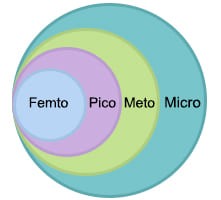Overview
Small cells have evolved mostly due to the needs associated with the constantly growing subscriber base of bandwidth-intensive applications. Small cell base stations (referred as HeNB in LTE terminology) are easily deployable, cost-effective, low-power devices. They are deployed to serve a limited number of users in a specified area and are generally classified as femtocell, picocell, metro cell, or microcell, depending upon the coverage area.
HSC has extensive experience in small cell design and development across baseband, protocol stack, backhaul and O&M domain. We have worked on the development of 3G and LTE small cells in architecture consultancy and product engineering modes. HSC has worked on designing advanced architectures for small cells to support both cellular (LTE) and WiFi radios using common hardware and software resources using commercial over-the-shelf solutions.
With effective network planning, macros and small cells can be combined to enhance the overall service experience greatly. The use of spectrum needs to be planned across these cells. Small cell base stations help augment the macro cells for network coverage. They extend network services to low coverage and dead areas where accessibility by macro base stations is difficult due to geographical challenges and other factors.
These compact (small cell) base stations are deployed for exclusive use in a particular area and thus improve quality of service and capacity. The higher quality signal enables the use of better transmission schemes and in return enhances the speed of data transfer. Small cell base stations connect to backhaul directly and offload the data traffic from the macro base station.
HSC recognizes that the deployment of small cells comes with its own challenges related to security, backhaul and O&M. Compared with marco base stations, small cells are deployed in relatively easy to access public places (malls, shopping centers, arenas, etc) and use the internet to backhaul traffic. Traditional backhaul techniques, like point-to-point, are difficult to implement in dense urban environments. Small cells are deployed in relatively larger numbers compared to macro base stations, which creates operational challenges. HSC’s experience in developing software for self organizing networks, OSS, Wireless security and backhaul systems (mmW backhaul) has complimented our wireless expertise in mitigating these deployment challenges. HSC has worked on several solutions to overcome the challenges noted above
LTE-WiFi Small Cell
Small cell solutions are primarily designed for licensed spectrums. However, with the growing need for (and focus on) the interworking of various radio access mechanisms, small cell solutions are also being designed to support multiple access techniques. The most attractive of these is the coexistence of WiFi and LTE. This design leverages the existing proliferation of WiFi APs in both home and enterprise networks. These existing deployments can then be taken to the next level by enabling HeNB functionality in these home nodes. Though such a solution sounds simple, it needs to be meticulously analyzed and designed.
The platform needs to be carefully selected to achieve the needed performance while dealing with the complexity of accommodating the LTE and WiFi stacks on the common platform. Shared RF needs to be planned cautiously.
The enterprise-level deployment plan needs to ensure effective bandwidth consumption. This is achieved by appropriate interconnects between enterprise terrestrial and wireless networks. Terrestrial –wireless interconnect ensures local traffic offloading. Wireless-wireless interconnects ensure load-balancing and overall capacity enhancements. Data is offloaded from EPC using SIPTO. LTE and WiFi networks balance out the data load in an effective manner using IFOM technique.
Security concerns are a prime factor in designing these small cell deployments. The transfer of data from AP to the core network needs to be sufficiently protected.
HSC has substantial experience in designing such solutions. Our wide experience in various wireless protocols like LTE/WiFi and our deep understanding of the interworking of various wireless techniques has enabled us to design effective solutions. HSC plays a crucial role in the design process for such systems by assisting in the overall design, picking relevant COTS, designing software that bridges between WiFi and LTE chipsets (by utilizing common resources), and much more.
Interference Management
Small cell base stations are low-power devices, so they need to be protected from macro cell interference in order to effectively operate. LTE has focused on this area of inter-cell interference coordination (ICIC), and the concept has since evolved from ICIC to eICIC and furthered to FeICIC. The solutions include mitigating interference at the cell edge, planned carrier aggregation schemes across small cells and macro cells, and resource planning with explicit transmission opportunities for small cells.
HSC has devised power optimization solutions for wireless networks and is currently working on eICIC.
SON
Small cell base station deployments can greatly benefit from self organizing and optimizing techniques. The SON solution of macro base stations needs to be extended to small cells.
There are many opportunities for SON that are introduced by small cell deployments such as managing inter-enterprise complexity of operation, balancing load when more than one AP is deployed, power optimization solutions, spectrum sharing solution, and beyond.
HSC has worked on multiple SON implementations. For more information, visit our page on self organizing networks(SON).
(Looking for something different? Head over to our radio and wireless engineering page for more information on our technical skill areas and the industries we work with.)

Product Engineering Services Customized software development services for diverse domains
Quality Assurance End-to-end quality assurance and testing services
Managed Services Achieve scalability, operational efficiency and business continuity
Technology Consulting & Architecture Leverage the extensive knowledge of our Domain Experts










